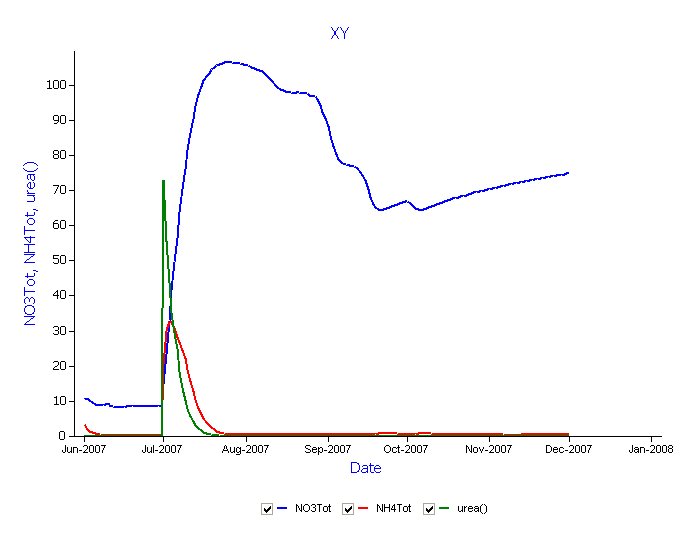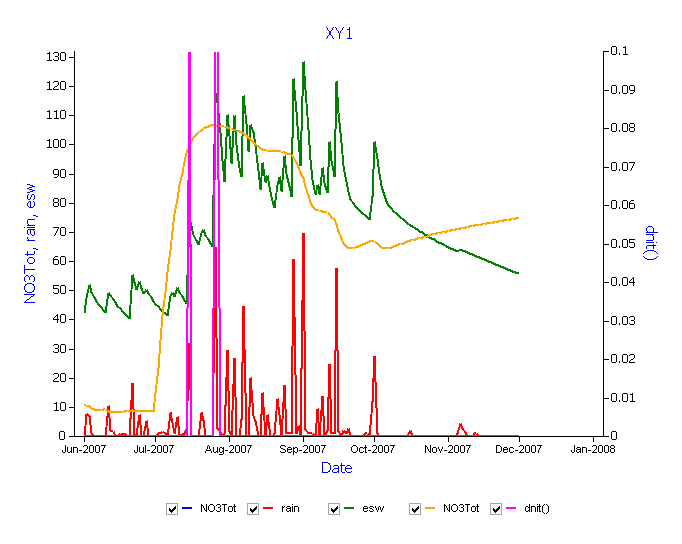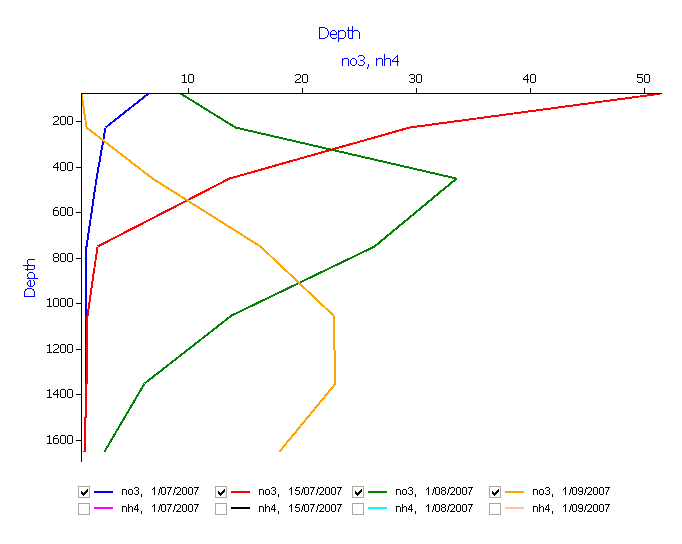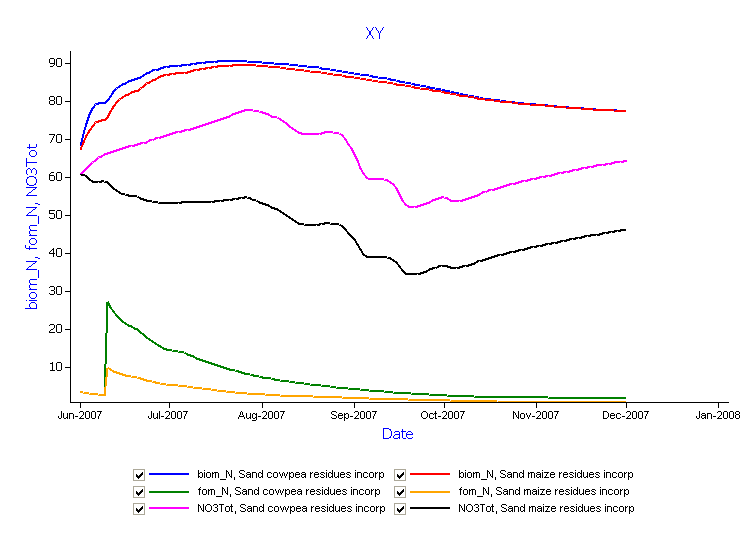Nitrogen cycling
In this exercise you will observe the movement of fertiliser nitrogen in a fallow situation: Urea to ammonium to nitrate and the loss of soil nitrate via denitrification.
This simulation will introduce us to editing a simple Manager rule and to more advanced features of graphing simulation results. Firstly we need to set up our weather and soil data. The simulation is on sand soil in the Melkassa area in Ethiopia.
The examples assume you have read and walked through the previous document:
- Start with a new simulation based on Continuous Maize
- Change simulation name to Sand Fertilised
- Save the file as N Fallow.apsim
- Choose Melkassa weather. (c:\apsim_workshop\met_files)
- Set the clock starting date: 1/6/2007 Ending date: 31/12/2007
- From International toolbox, drag a “Kenya, Masii district Sand, Alfisol (PAWC = 87mm, 1.8m)” soil description onto the ‘paddock’ node of the simulation tree, (located under Soils->Kenya). Remember to rename it – ‘Sand’
- Set the Starting water to 50% full, evenly distributed.
- Set the Starting nitrogen to 10 kg/ha NO3 and 5 kg/ha NH4
- Set the initial surface organic matter to 2000 kg/ha maize residues.
- Remove the maize component from the paddock, and all manager rules from the manager folder.
- Drag a Fertilise on fixed date to your Manager component. (“Standard toolbox” -> “Management” -> “Manager (common tasks)” )
- Change the fertiliser management parameters to apply 100 kg/ha of urea_N on 1-Jul. (leave the “Don’t add fertiliser if N in top 2 layers exceeds (kg/ha)” property, and set the “Module used to apply the fertiliser” to “fertiliser”)
- Make sure your simulation contains a Fertiliser component in your paddock. Even though it doesn’t have any changeable properties it is still necessary when fertiliser is to be applied.
- Choose these variables to report:
Component Variable name Clock dd/mm/yyyy as Date Year Day Met Rain Soil dlayer
The thickness (in mm) of each soil layeresw
Extractable Soil Water (mm)drain
Drainage (mm)NO3() as NO3Total
Nitrate Nitrogen, summed over profile, aliased to NO3Total. (the as keyword creates an alias)NH4() as NH4Total
Ammonium Nitrogen, summed over profile, aliased to NH4TotalUREA() DNIT() NO3
Nitrate Nitrogen, layeredNH4
Ammonium Nitrogen, layered - Change reporting frequency (in My Variables Events) to end_day.
- Run the simulation
- Create a graph of date vs urea, total ammonium and total nitrate. Drag an XY graph component onto the simulation. On the Plot node set “Point type” to “None” and leave “Type” as “Solid line”.

Question: Why does the above graph look the way it does?
Illustrating the extent and conditions required for denitrification losses
Create a new chart of Date vs Rain, DNIT (on Right Hand Axis), ESW and NO3Total.

From this chart you can see that some nitrogen is lost via denitrification when large amounts of nitrate is available in saturated soil conditions. But why do you think the level of denitrification is so low (0.1 kgN/ha/day) in this case?
Exploring vertical movement of nitrate, after fertilisation, through the soil profile
Let’s look at the distribution of nitrate through the soil profile at 15 and 31 days after fertilisation, and again at 2 months.
- Create a depth graph (from the graph toolbox), and expand all the children. Go to the lowest depth node, and select (so that they show a tick mark) the dates 1/07/2007, 15/7/2007, 1/8/2007 and 1/9/2007. Go to the Plot node and select NO3 and NH4 as the X variables. Leave the Y variable as “Depth”. Select the top graph node (“Depth”) and untick the checkboxes for the “nh4” lines.Depth plots can only be done when the simulation has dlayer in the output file along with at least one other layered variable. This is why we included no3 and nh4 as layered variables in the output file and not just the summed variables NO3Total and NO4Total.

From this chart you can see the distribution of nitrate in the soil profile on day 1, 15 and 31 days after the addition of urea fertiliser and at 2 months.
Movement of Nitrogen between Organic Matter Pools
In this exercise we track the movement of nitrogen in fresh organic matter into soil microbial biomass and further into mineral nitrogen. We shall compare the flows in these processes for incorporation of two types of residues – maize and cowpea.
- Make a copy of the Sand fertilised simulation by dragging to the top node in the tree (Simulations) This setup already includes maize residues on the surface at 2000 kg/ha
- Change starting NO3-N to 60 kg/ha (36 and 24in each of the 2 layers), leaving NH4-N at 5 kg/ha
- Remove Fertilise on fixed date from your paddock component
- Drag Tillage on fixed date to your ‘paddock’ component for this new simulation. (open “Standard toolbox” -> “Management” -> “Manager (common tasks)” )
- Change the Tillage management parameters to:
date = 10-Jun
Module used to apply the tillage = Surface Organic Matter
Tillage Type = user_defined
User defined depth of seedbed preparation = 100 (mm)
User defined fraction of surface residues to incorporate = 1.0 - Change simulation name to Sand maize residues Incorp.
- Choose these variables to report:
Component Variable name Clock dd/mm/yyyy as Date Soil Biom_n() as biom_n_Tot Fom_n() as fom_n_Tot NO3() as no3_Tot - Create a copy of the Sand maize residue incorp simulation and call it Sand cowpea residue incorp.
- Change the initial surface residue parameters to 2000 kg/ha of Cowpea (type) residue. Set the C:N ratio to 20. (Remember you may want to change the Organic Matter pool name to cowpea as well)
- Run the two simulations for residue incorporation.
- Graph both residue incorporation simulations with no3_tot (right hand axis), biom_n_tot and fom_n_tot. (Drag an XY graph onto the top node (simulations), open the ApsimReader node and point to the 2 output files)

Inspect the change in fresh organic N in residues (fom_n) with time.
Note that there is a steep increase in the first few days when tillage incorporates the surface residues and this material is passed onto the soilN modules as FOM. Soil fom_n for legume is higher than for maize residues reflecting the differences in N content of the 2 materials as determined by the C:N ratios input to the model.
Differences between maize and legume dynamics in decomposition of FOM and its N content can be seen in the transfer of N into the microbial N pool (biom_n_tot), and the effects of this transfer on the net immobilisation/mineralisation of organic N from/to the soil nitrate pool.
What explains the large decreases in NO3-N after August 2007?
